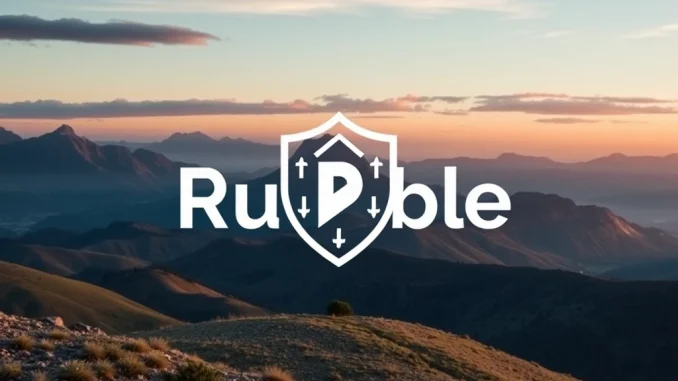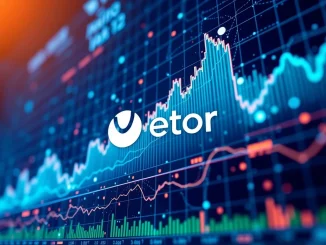
Big news from the world of online video and cryptocurrency! Rumble, the popular video platform, is making a significant move into the digital asset space. The company is gearing up to launch its very own **Rumble wallet**, a development announced by CEO Chris Pavlovski on social media.
What is the Rumble Wallet and Why Does it Matter?
This isn’t just any digital wallet; Rumble’s offering is specifically designed as a **non-custodial wallet**. This means users will have complete control over their private keys and, consequently, their cryptocurrency assets. Unlike custodial wallets where a third party holds the keys, a non-custodial approach puts the user in the driver’s seat. This aligns with core principles of decentralization often championed in the crypto community.
The wallet is expected to support major cryptocurrencies, specifically mentioning support for **Bitcoin wallet** functionality and integration with **Tether**, the largest stablecoin by market capitalization. This combination suggests Rumble aims to cater to users interested in both the premier digital store of value (Bitcoin) and a widely used stable asset for transactions or holding value without volatility.
Key Features and Expected Launch
Based on the announcement, here’s what we know:
- Type: Non-custodial
- Supported Assets: Bitcoin, Tether (and likely other stablecoins)
- Expected Launch: Q3 2024
- Platform: Rumble
The Q3 launch timeline suggests the service could be available anytime between July and September of this year. Integrating a **crypto wallet** directly into the Rumble platform could streamline interactions for users who are interested in both content and digital assets.
Non-Custodial vs. Custodial: Understanding the Difference
It’s crucial to understand what a **non-custodial wallet** offers compared to a custodial one. Here’s a simple breakdown:
| Feature | Non-Custodial Wallet | Custodial Wallet |
|---|---|---|
| Control of Private Keys | User holds the keys | Third party (e.g., exchange) holds the keys |
| Security Responsibility | User is responsible for security and backups | Third party is responsible for security |
| Access to Funds | User has direct access, no permission needed | Access depends on the third party’s availability and rules |
| Risk of Loss | Risk if user loses keys or seed phrase | Risk if third party is hacked, goes bankrupt, or freezes assets |
| Common Use Cases | Long-term holding, interacting with DeFi, privacy | Trading on exchanges, ease of use for beginners |
Rumble’s choice to go non-custodial emphasizes user sovereignty and control, a move that will likely appeal to individuals prioritizing independence in managing their digital wealth.
Why Tether Support is Important
The inclusion of **Tether** (USDT) support is particularly noteworthy. Tether is a stablecoin pegged to the US dollar, meaning its value is intended to remain stable around $1. This makes it useful for various purposes within the crypto ecosystem:
- Store of Value: Users can hold value in a stable asset without converting back to traditional fiat currency.
- Transactions: USDT is widely used for fast and low-cost transfers across different blockchains.
- Trading: It serves as a common trading pair on exchanges.
Integrating Tether allows Rumble users to potentially hold, send, or receive a stable digital currency directly within the platform’s wallet, adding practical utility beyond just Bitcoin.
What Does This Mean for Rumble and Its Users?
This move positions Rumble not just as a video platform but as a potential player in the Web3 space. By offering a **crypto wallet**, Rumble could facilitate various future integrations, such as:
- Creator monetization via crypto payments or tips.
- Integration with NFTs or other digital collectibles.
- Enabling microtransactions within the platform.
For users, having a built-in **Rumble wallet** that is non-custodial provides a convenient way to manage Bitcoin and Tether without relying on external exchanges or third-party wallet providers for basic storage and transactions within the Rumble ecosystem.
Actionable Insight: Preparing for the Rumble Wallet
If you’re a Rumble user interested in this development, here are a few things to consider as Q3 approaches:
- Educate Yourself: Learn the basics of how non-custodial wallets work, especially the importance of securely backing up your seed phrase.
- Understand Risks: With full control comes full responsibility. Losing your private keys means losing access to your funds forever.
- Stay Updated: Follow official announcements from Rumble for the exact launch date and details on how to set up and use the wallet.
This is a significant step for Rumble and highlights the growing convergence between content platforms and the digital asset world. The availability of a non-custodial **Bitcoin wallet** and **Tether** support within the platform could open up new possibilities for both creators and viewers.
Conclusion: A Secure Step into Crypto for Rumble
Rumble’s planned launch of a non-custodial **Rumble wallet** in Q3 2024, complete with support for Bitcoin and Tether, marks a notable expansion for the platform. By choosing a non-custodial model, Rumble is empowering its users with direct control over their digital assets, aligning with key principles of the crypto space. This development has the potential to integrate cryptocurrency more deeply into the user experience on Rumble, offering new avenues for interaction and value exchange. As the launch window approaches, users interested in crypto on the platform will be watching closely.



